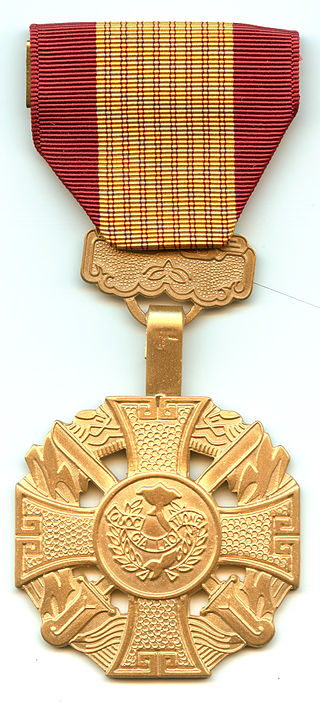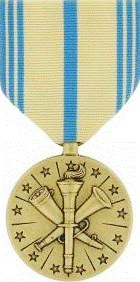
The Bronze Star Medal (BSM) is a United States Armed Forces decoration awarded to members of the United States Armed Forces for either heroic achievement, heroic service, meritorious achievement, or meritorious service in a combat zone.

The Legion of Merit (LOM) is a military award of the United States Armed Forces that is given for exceptionally meritorious conduct in the performance of outstanding services and achievements. The decoration is issued to members of the eight uniformed services of the United States as well as to military and political figures of foreign governments.
The Presidential Medal of Freedom is the highest civilian award of the United States, along with the Congressional Gold Medal. It is an award bestowed by the president of the United States to recognize people who have made "an especially meritorious contribution to the security or national interests of the United States, world peace, cultural or other significant public or private endeavors." The award is not limited to U.S. citizens and, while it is a civilian award, it can also be awarded to military personnel and worn on the uniform. It was established in 1963 by President John F. Kennedy, superseding the Medal of Freedom that was established by President Harry S. Truman in 1945 to honor civilian service during World War II.

The Republic of Vietnam Gallantry Cross also known as the Vietnamese Gallantry Cross or Vietnam Cross of Gallantry is a military decoration of the former Government of South Vietnam. The medal was created on August 15, 1950 and was awarded to military personnel, civilians, and Armed Forces units and organizations in recognition of deeds of valor or heroic conduct while in combat with the enemy.

The United States Armed Forces awards and decorations are primarily the medals, service ribbons, and specific badges which recognize military service and personal accomplishments while a member of the U.S. Armed Forces. Such awards are a means to outwardly display the highlights of a service member's career.
The National Defense Service Medal (NDSM) is a service award of the United States Armed Forces established by President Dwight D. Eisenhower in 1953. It is awarded to every member of the US Armed Forces who has served during any one of four specified periods of armed conflict or national emergency from June 27, 1950 through the present. Combat or "in theater" service is not a requirement for the award.
The World War II Victory Medal is a service medal of the United States military which was established by an Act of Congress on 6 July 1945 and promulgated by Section V, War Department Bulletin 12, 1945.
To be mentioned in dispatches describes a member of the armed forces whose name appears in an official report written by a superior officer and sent to the high command, in which their gallant or meritorious action in the face of the enemy is described.
A "V" device is a metal 1⁄4-inch (6.4 mm) capital letter "V" with serifs which, when worn on certain decorations awarded by the United States Armed Forces, distinguishes an award for heroism or valor in combat instead of for meritorious service or achievement.

A 5⁄16 inch star (9.7mm) is a miniature gold or silver five-pointed star that is authorized by the United States Armed Forces as a ribbon device to denote subsequent awards for specific decorations of the Department of the Navy, Coast Guard, Public Health Service, and National Oceanic and Atmospheric Administration. A gold star indicates a second or subsequent decoration, while a silver star is worn in lieu of five gold stars.

A service star is a miniature bronze or silver five-pointed star 3⁄16 inch in diameter that is authorized to be worn by members of the eight uniformed services of the United States on medals and ribbons to denote an additional award or service period. The service star may also be referred to as a campaign star or battle star depending on which award the star is authorized for and the manner in which the device is used for the award.
The Citation Star was a Department of War personal valor decoration issued as a ribbon device which was first established by the United States Congress on July 9, 1918. When awarded, a 3⁄16-inch (4.8 mm) silver star was placed on the suspension ribbon and service ribbon of the World War I Victory Medal to denote a Citation (certificate) for "Gallantry In Action" was awarded to a soldier, or to a marine or attached to the Army's Second Division, American Expeditionary Forces. The Citation Star was replaced in 1932 with the introduction of the Silver Star Medal.
The Global War on Terrorism Expeditionary Medal (GWOT-EM) is a United States Armed Forces award created by George W. Bush on 12 March 2003, through Executive Order 13289. The medal recognizes those military service members who have deployed overseas in direct service to the War on Terror from 11 September 2001 to a date to be determined. Prior to 30 April 2005, the medal was awarded for service within Iraq and Afghanistan, but has been replaced with the Iraq Campaign Medal and Afghanistan Campaign Medal and now serves primarily as recognition for personnel who have deployed in support of the War on Terror to locations beyond Iraq and Afghanistan. In a similar fashion the Inherent Resolve Campaign Medal is now issued instead for service in the fight against ISIS, with eligibility retroactive to 15 June 2014.

The Armed Forces Reserve Medal (AFRM) is a service medal of the United States Armed Forces that has existed since 1950. The medal recognizes service performed by members of the reserve components and is awarded to both officers and enlisted personnel. The medal is considered a successor award to the Naval Reserve Medal and the Marine Corps Reserve Ribbon, which were discontinued in 1958 and 1967, respectively.

The Congressional Gold Medal is an award bestowed by the United States Congress. It is Congress's highest expression of national appreciation for distinguished achievements and contributions by individuals or institutions. The congressional practice of issuing gold medals to occasionally honor recipients from the military began during the American Revolution. Later the practice extended to individuals in all walks of life and in the late 20th century also to groups. The Congressional Gold Medal and the Presidential Medal of Freedom are the highest civilian awards in the United States. The congressional medal seeks to honor those, individually or as a group, "who have performed an achievement that has an impact on American history and culture that is likely to be recognized as a major achievement in the recipient's field long after the achievement." However, "There are no permanent statutory provisions specifically relating to the creation of Congressional Gold Medals. When a Congressional Gold Medal has been deemed appropriate, Congress has, by legislative action, provided for the creation of a medal on an ad hoc basis." Thus, there are generally fewer gold medals than presidential medals. U.S. citizenship is not a requirement.

The Republic of Vietnam Civil Actions Medal also known as the Vietnam Civil Actions Medal or Civil Actions Medal, is a military decoration of the former South Vietnamese government (1955–75). The medal was created on May 12, 1964 during the Vietnam War. The Civil Actions Medal was awarded to the South Vietnamese military and its allies' military personnel or units that performed outstanding achievements in the field of civil affairs. The medal was awarded in two classes, with the first-class intended for commissioned officers and the second class for enlisted personnel. Individuals who were cited received the medal, ribbon, and a citation.
The United States Armed Forces authorize certain medal and ribbon devices that may be worn if authorized on a defined set of United States military decorations and awards. The devices vary between 3⁄16 inch to 13⁄32 inch in size and are usually attached to suspension and service ribbons of medals and to unit award ribbons. The devices are usually made of brass or metal alloys that appear gold, silver, or bronze in color with either a dull or polished look. The devices may denote additional awards of the same decoration or award, an award for valor or meritorious combat service, participation in a particular campaign, periods of honorable service, specific events, and other special meanings. These are sometimes referred to as award devices, but are most commonly referred to in service regulations and Department of Defense instructions simply as "devices" for awards and decorations.
Awards and decorations of the United States government are civilian awards of the U.S. federal government which are typically issued for sustained meritorious service, in a civilian capacity, while serving in the U.S. federal government. Certain U.S. government awards may also be issued to military personnel of the United States Armed Forces and be worn in conjunction with awards and decorations of the United States military. In order of precedence, those U.S. non-military awards and decorations authorized for wear are worn after U.S. military personal decorations and unit awards and before U.S. military campaign and service awards.

The Combat Action Medal (CAM) is a decoration of the United States Air Force and United States Space Force to recognize airmen and guardians for active participation in ground or air combat.















